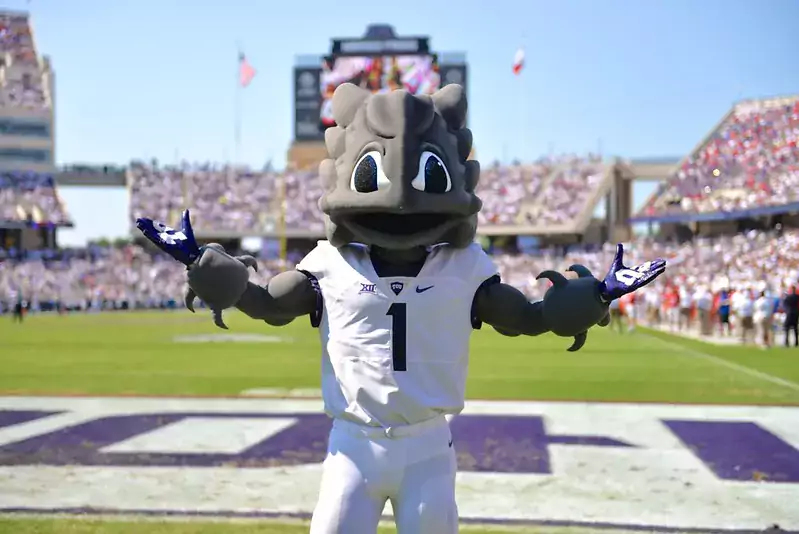
Fiesta Bowl Fee Fi Foe Film: TCU Defense 2022

Previously: TCU Offense
Welcome back for the defensive side of the Fiesta Bowl matchup. The Big XII is not known for playing much defense and TCU is not totally immune from that. They rank 33rd in SP+, middle to upper half of the P5. The Frogs are among the best defenses in their conference, but compared to the rest of the country, their efficiency metrics are nothing to write home about. Are they a unit with real concerns when faced with a team like Michigan, or are they being underrated by virtue of the tough offenses they play each week, a luxury a B1G team doesn't get? Let's find out:
The Film: We're sticking with the KSU Big XII Championship Game footage for this one due to recency and also because it was TCU's one loss on the season. However, I'm also using tape from the Texas game (though I did not chart it), since that was TCU's strongest defensive performance by a considerable margin, attempting to analyze what they did well against Texas but didn't against Kansas State.
Personnel: Click for big or here for PDF.
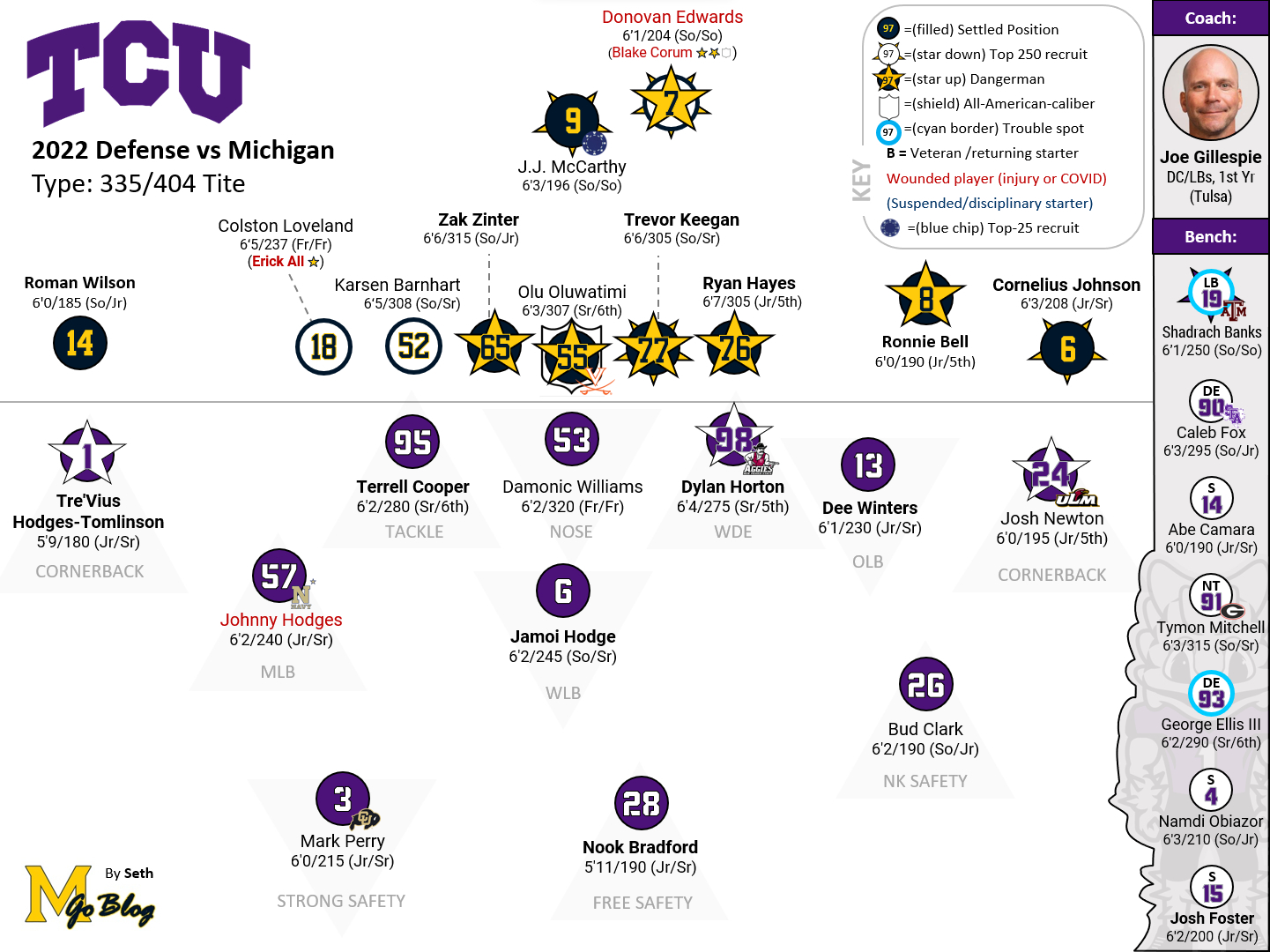
TCU runs a 3-3-5 defense, and it starts on the line with WDE Dylan Horton. He began his career as a 6'4" safety with New Mexico in 2018-19 before transferring to the Frogs and converting to a defensive end. Horton has beefed all the way up to 275 and I think he's a very good football player. He can rush the passer, set the edge, play in space, anything you want him to do. Horton is the most impactful DL for TCU, since their other two are just guys. At NT there's Damonic Williams, who has hung in there as a 3* Tr Fr, boasting college size at 320 lbs. and good athleticism and wingspan. Williams has been able to hold up against Big XII doubles to this point, but Michigan is a different beast. The third starter in the trenches is Terrell Cooper, who I don't have much to say about. They rotate in guys like Tymon Mitchell and George Ellis III, who are definite downgrades in your author's view.
The LB level is filled with traditional, old school players who love to thump like they're from the 90s. The two "true" LBs are Navy transfer Johnny Hodges, who missed the Big XII Championship Game with a hamstring issue, and Jamoi Hodge. They are listed at 240 and 245 lbs., respectively, giving you a sense of the size here. Shadrach Banks, who filled in for Hodges against K-State, is 250 (he received a cyan for a rough effort). They are husky looking boys who do not move in space like a Junior Colson but they are physical and love to get downhill. The crux of the TCU front six is allowing those LBs to pick gaps and slash through, with force and aggression taking on blocks and crunching the ballcarrier. They have a "HSP"/SLB in Dee Winters, who is the lightest of the bunch at 230.... he had a very up-and-down performance against K-State. I didn't think he was cyan-level bad but PFF does (ironically, Big XII voters named him 1st Team All-Conference, so go figure). Make of that what you will.
The TCU secondary has been given a major boost through the emergence of a pair of legit cover corners, Josh Newton and Tre'vius Hodges-Tomlinson, both of whom were named 1st Team All-Big XII. Newton was a transfer portal pickup last offseason from Louisiana-Monroe, while Hodges-Tomlinson is a veteran originally recruited to the program by Gary Patterson. Neither were highly touted recruits but both have emerged as very good NCAA players, Newton with several impressive PBU's against KSU, while Hodges-Tomlinson was given the David Long "we don't even bother to throw at you" treatment. They have allowed TCU's safeties to work the middle of the field and run defend more, a boost considering the other players in this secondary are merely decent. Safeties Mark Perry and Nook Bradford are solid, as is Nk Bud Clark, but they lean on the two outside corners as a unit. Abe Camara has been a starter at times this season at safety, while Namdi Obiazor and Josh Foster rotate in. I don't have too many notes on them.
[AFTER THE JUMP: A Big XII Defense]
Base set: As noted earlier, TCU primarily runs a 3-3-5.
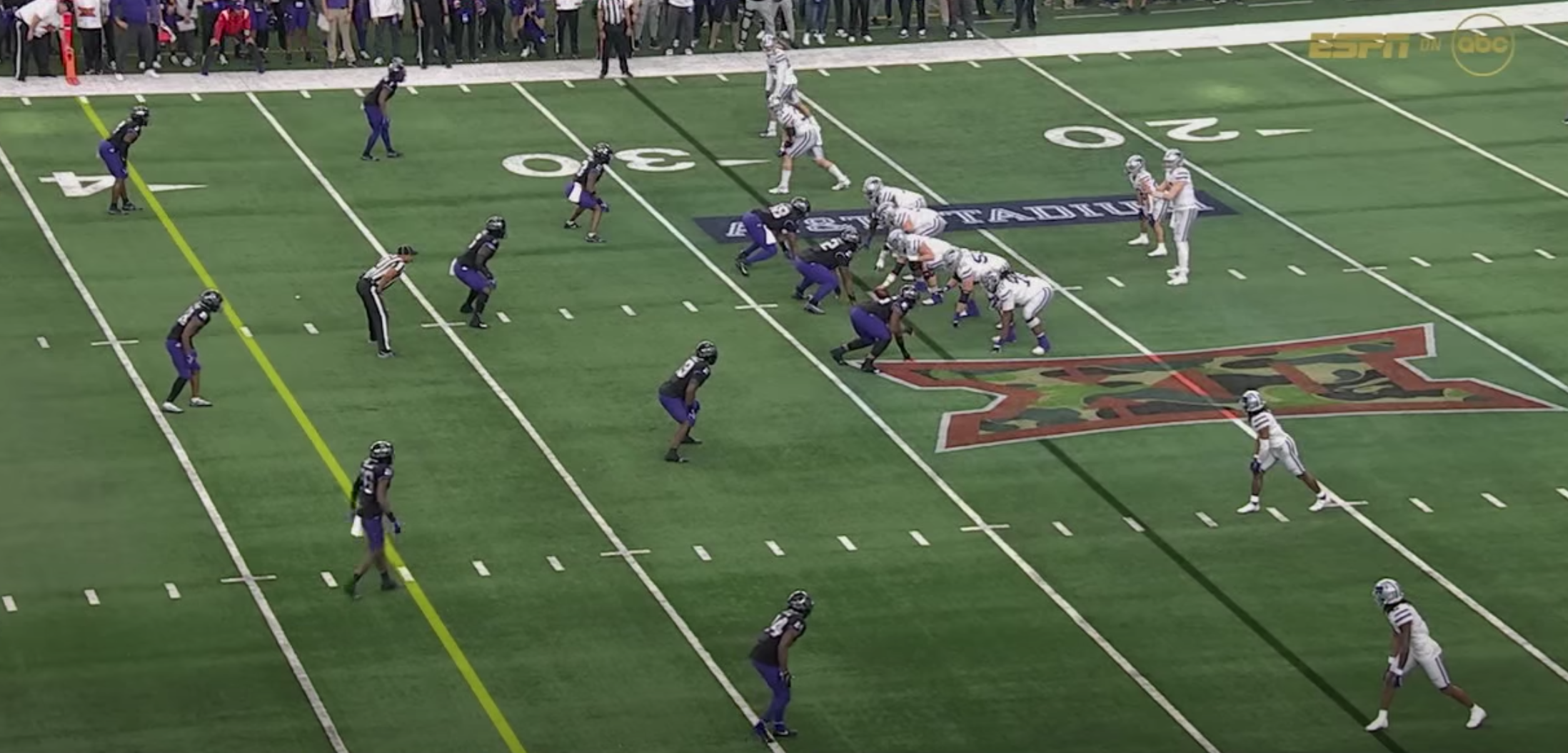
Three down linemen and three LBs, the husky ILBs and then the marginally smaller SLB/HSP (lined up towards the top of the screen at the 31) + five DBs. There are the star outside CBs, Newton at the bottom and Hodges-Tomlinson at the top, the nickel Clark lined up high in the slot towards the bottom, and then two high safeties. This is what they looked like on the vast majority of charted plays against KSU. Sometimes they'll bring the SLB down towards the line of scrimmage to run the 404 Tite front.
TCU did show 5-2-4 against KSU in short yardage situations, which is something of interest to note when analyzing a matchup with a team like Michigan.
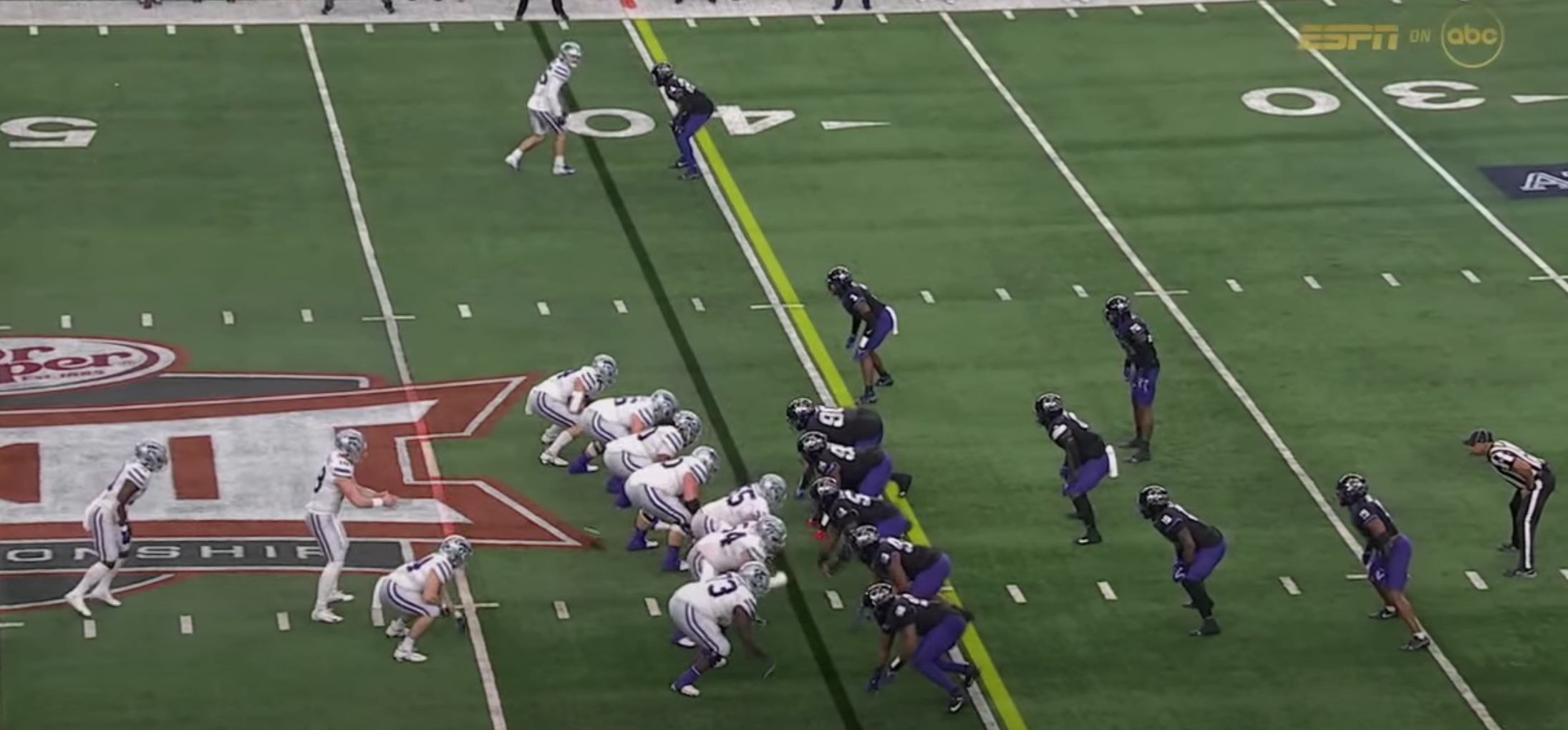
Man or zone coverage: TCU plays a base Cover 2, which I'm using as an umbrella because they feature variants like Tampa 2 and Inverted Tampa. All this puts them in the zone coverage bucket and their discipline and comfort running their base coverages, while not Iowa-level, is impressive. It's a well-coached defense overall (needs to be to overcome talent limitations) and they know how to play their base stuff.
Pressure: Well this is interesting. Within its 3-3-5 base, TCU rarely brought more than just its three linemen against K-State, rushing three on a whopping 68% of snaps(!), while blitzing only 13% of the time. Rushing four, standard for most teams, was only used 19% of the time in that game. They were very much a "drop eight into coverage" team against the 'Cats, but having seen some of their other games, this was more matchup specific. They were far blitzier against Texas, a team they tended to load up the box against, activating LBs as passrushers against the Longhorns often. I'd think their approach against Michigan looks more like the gameplan vs. Texas than KSU.
Dangerman: I debated between the two corners, but decided to tab Tre'vius Hodges-Tomlinson for this honor. He didn't pop up a ton in my notes for the KSU game, but that is the best compliment you can give a cover corner. If no one is throwing at you, that's a good sign for your ability to cover. When he did pop up, he was in the right place:
On this next one he wasn't able to get a PBU because the ball was overthrown, but Hodges-Tomlinson was in position again:
Texas targeted him much more, and he was able to get an INT in that one:
When you look under the hood, Josh Newton's PFF grades have been a little up and down, some incredible weeks and some rough ones, whereas Hodges-Tomlinson has been somewhere between good and great every week. He hasn't registered a grade below 64 since the SMU game and gets it done week in in and week out.
Overview
Let's get this over with to start: the biggest problem I had in scouting TCU is there are no accurate comparisons between the teams TCU has played and the sort of offense that Michigan is. The Big XII and B1G are radically different conferences on offense, but within the B1G, you can find teams like Purdue that have some similarities. There is no proper comparison in the Big XII for what Michigan is. Very few teams want to load up on TEs and mash your face in to begin with, and among the teams who try it from time to time, no one has the mix of talent and impeccable execution/coaching in the trenches that this Michigan team has.
We talked about this when Ohio State hired Jim Knowles in the offseason, but there is a difference between a Big XII defense and a B1G defense and what they're set up to try and defend. Scanning through the list of TCU's FBS games, not a single opponent this season rushed it 50 times in a game against the Horned Frogs. Michigan had a four game stretch in the meat of the B1G play where they ran it 55, 52, 53, and 49 times in consecutive games. Michigan is a unique beast in the B1G, but in the Big XII, they would be an alien life form. A defense built to conquer the land of the spread passing attack and the Air Raid meets Jim Harbaugh. That's what makes this matchup so compelling.
Kansas State, as Brian pointed out on the podcast, did some Michigan-like things, which is why it was useful to chart this game. The 'Cats came out in 12 personnel a decent bit and the response by TCU was to stick to their base. Sometimes it was a good idea. Other times it looked like this:
Yet they rarely deviated! There were some successes in 3-3-5 vs. 12, like this clip:
The tendency certainly piqued my interest, though, and it's a good way to begin the intro to this difficult-to-forecast matchup.
Let's continue in run defense. Their DL outside of Horton doesn't do a ton for me and I think it will be possible to blow these guys off the line of scrimmage with Michigan's OL personnel. I'm not as confident in this as some analysts on twitter, but clips like this make me believe that Michigan may be able to just toss these guys around:
That said, this isn't a team where defeating the DL is the only task to beating them on the ground, and the clip above shows that. Kansas States blows TCU off the line of scrimmage, but the run only goes for 5 because the LBs are right there. TCU is generally able to hang in against the run with their base set because their LBs are very good at recognizing gaps and getting downhill. If you don't do anything to mess with them, they will be difficult to run through once you get to the second level. Texas didn't do much of anything to put the LBs in conflict and didn't threaten vertically through the air due to a brutal day from Quinn Ewers. The result was TCU bringing the safeties down to stuff the box further and allowing the LBs to go on instinct when it looked like a run play. Any wins Texas had in the trenches were completely negated by the gaps being all gummed up and they got nothing on the ground. Example:
Here's a screenshot I took of one such run giving you a Texas POV angle:
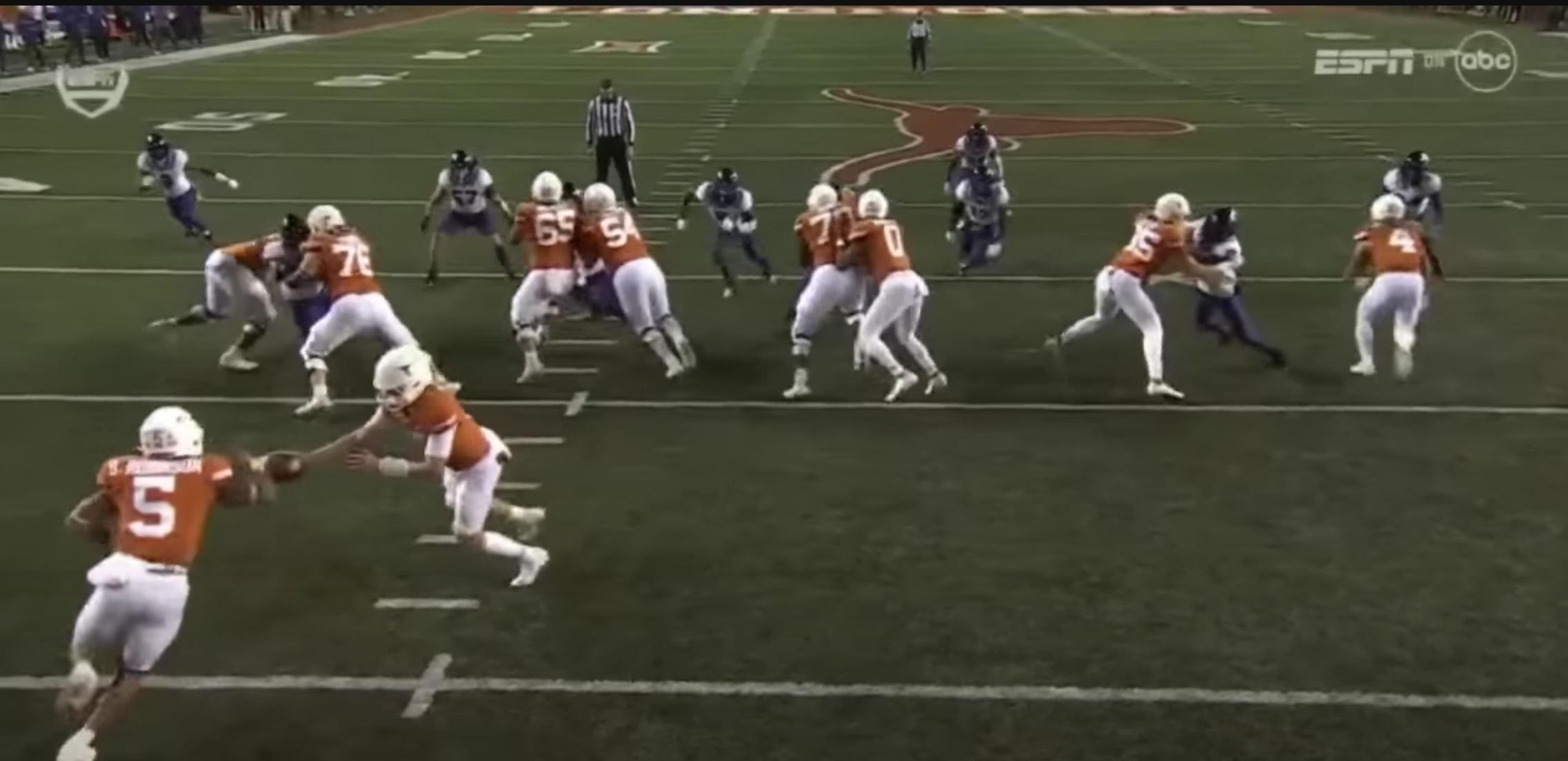
You've got doubles opening up plenty of lanes for Bijan Robinson to run through, but TCU has a player at the second level ready in every conceivable place. This is what JH and Sherrone Moore have to be aware of- you need to introduce misdirection or else the LBs will feast. If you do thin the box out a bit, opportunities pop up because the LBs are heavy and not the most athletic. They aren't going to be able to cover a ton of ground if they aren't able to recognize what's going on right from the get-go.
KSU's response was to hit them to the perimeter, something I think Michigan will look at mixing in with Donovan Edwards as the lead back. Jet sweeps were a core element of KSU's playbook for this game and it had success:
I found that this was far more effective than Texas' tactic to stretch the field horizontally, which was to dial up a ton of WR screens, in true Big XII fashion. TCU's players, at every level, are physical and want to hit. Corners coming down and hammering their blockers helped disrupt that right in its tracks. Kansas State didn't throw many of those and by going to the jet sweep, were able to open up room in the box for their between-the-tackles runs. Here's another one:
I was debating with someone the strategy Michigan will take in the rushing game, targeting the perimeter to take advantage of the thick and slower TCU LBs, or simply try to load up and crush a 3-3-5 front, and after thinking about it, the answer is likely a mix of the two. Playing the two styles off each other, while weaving in QB run reads, will complete the run package. The QB run reads that K-State ran showed signs of success:
When you tie it all together, meat up front attacking the DL (particularly if any reserves are in), putting the LBs in conflict, threatening horizontally, and adding in the QB run element, you can get explosives against the TCU defense on the ground. It looks like this:
Hitting the deep shots will help as well, which is the one thing Texas could not do, creating the stifling run defense that TCU had in that game. When you scroll through the RB statlines for TCU's opposition this season, you see that quite a few rushed for 5, 6 YPC, but Texas sat back at a measly 2.53 YPC. It was mostly because of a lack of that vertical passing component to keep the safeties honest, poor play from WRs catching balls on screens, and not messing with the TCU LBs at all.
The safeties are also allowed to play more in the run game because of those corners. I've already shown you Hodges-Tomlinson, but now I give you Josh Newton:
One more:
Also first team All-Big XII. In response to this, I propose taking a gander at attacking the seam. Yeah, you can look for the customary Cov2 hole shot, but the most vulnerable area of TCU's pass coverage against Kansas State seemed to be a receiver running down the seam between the LB and the safety. Like say, this:
Here's one they didn't connect on but had wide open too:
The TCU LBs and safeties are not athletic enough to be perfect against these shots and to me, this smells like another Colston Loveland game. Michigan can weaponize his athleticism and leaping ability against shorter, heftier, and athletically limited 'backers and safeties, the latter of whom is a relative weakness of the secondary compared to the star corners.
If Donovan Edwards is ready to be a receiver again, he's another player who could be devastating down the seam. K-State tried it a couple times with star RB Deuce Vaughn and it was open, though the QB Will Howard missed him:
I want to circle back and talk about the pressure component of this a bit. I stated earlier that TCU was mostly in "drop eight" mode against K-State, but that's not what they always are. They have the ability to crank it up and tended to do so as the game went along against the 'Cats, when the Frogs were getting battered defensively. TCU has the same zero blitzes that OSU used in The Game in their back pocket, this one to sack Howard:
If you want to look through the full Texas highlights, you'll see plenty of aggressive blitzes, as Ewers' struggles and a doofus performance from Steve Sarkisian and everyone else on the offensive side of the ball for the Longhorns allowed TCU to pin their ears back:
In terms of organic passrush, TCU's best DL is Dylan Horton. He got a sack on Howard to close out the half:
DE #98 to the bottom of the DL
Horton also really popped in the Texas game and made me a fan of his. All this said, the DLs are really there to draw doubles and create lanes for the LBs to get to the backfield in the passrush. If TCU is only rushing three, and they did that a whole lot against K-State, they are conceding to you plenty of time to throw the ball. Thus, in those situations it will be up to JJ to look at the zone coverage and pick his spots. There are plenty of options in TCU's zone over the middle of the field and Will Howard did a solid job finding those:
It will be up to JJ McCarthy to do the same.
What does this mean for Michigan?
TCU has a solid defense, one that has navigated the Big XII reasonably well but it is not without weaknesses. Its biggest is the lack of talent, with not a single top 300 composite recruit among the starters, and just one among the reserves. That leads to athletic limitations at a number of spots, and as I've highlighted, the LB position stands out with its heavy, old school pieces. That sort of player has clear limitations and is exploitable by Michigan. As I've outlined, stretching the field horizontally and going against the LBs in coverage are the best ways to take advantage of this edge.
The big looming question for this matchup is what happens in the trenches, and how Michigan targets the LBs in the running game. There are several non-partisan football analyst people who think Michigan will have a seismic advantage on the line, but until we see the game begin, it's tough to say. No question that TCU hasn't seen anything like the Oluwatimi and Zinter Duo tandem this season, though. But even if Michigan obliterates TCU in the trenches, they'll need to figure out ways to screw with the LBs, putting them in the wrong gap or making them run the wrong way. Michigan's running schemes are complex enough to think that is decently likely, but it is imperative. If the LBs have trouble diagnosing the play, the Frogs are in big trouble.
Overall, Michigan will be facing a competent, well-coordinated and coached defense. It is also not an elite defense. And coming from the Big XII, it is set up to stop spread passing attacks, not teams with Michigan's identity. TCU will have to prove something about their D more than Michigan will have to prove something about their O and that's what is worth pointing out. If Michigan sticks to their base stuff, given how overpowering and complex their running game is, that should be enough to get it done, so long as they get a solid day from JJ McCarthy. Hitting Schoonmaker or Roman Wilson deep down the field will go a long way towards opening up the box even more, and allowing Michigan's punishing game to do the rest.
December 29th, 2022 at 10:35 AM ^
Hodges-Tomlinson Won the Thorpe award for best CB in CFB…probably warrants the dangerman/shield status.
December 30th, 2022 at 8:52 AM ^
Yeah I was surprised that the Thorpe Award was not mentioned in this preview.
December 29th, 2022 at 11:02 AM ^
That one run play that was stopped was trying to be too cute. The OL pulls one way then turns around and pulls the other.
December 29th, 2022 at 11:12 AM ^
Their defensive scheme is entirely built around defending Big12 air raid offenses, for good reasons. Our offense is the exact opposite of that. I genuinely cannot wait to watch them try and defend heavy 8 man fronts in motion, with over-aggressive linebackers, and safeties and corners trying to match up against TEs. Our power run will force them to vacate the edge and middle, where our TEs, JJs legs, and Edwards can torch them. We've demonstrated repeatedly against tough defenses that we can march down the field and punch it in, TCU has repeatedly demonstrated that if they don't get a home run play, they're all but incapable of punching it in the end zone.
December 29th, 2022 at 11:26 AM ^
I don't disagree, but "Our power run will force them to vacate the edge and middle..." Where are they going to go? Seems like they just vacated the field! LOL!!
December 29th, 2022 at 3:22 PM ^
Into the box.
December 29th, 2022 at 11:27 AM ^
Two words: Schoon maker
December 29th, 2022 at 2:02 PM ^
Two more: Colston Loveland...
December 29th, 2022 at 11:36 AM ^
Seems like they are Penn State plus on O and Iowa light on D
I like Michigan’s chances.
December 29th, 2022 at 12:29 PM ^
I hope Michigan screws with TCU's LBs early and often because we are 100% going to see this until we make them pay for it.

If we start getting TCU LBs with question marks over their heads, they can get paved. Since this isn't some generic October Big Ten game, I think Harbaugh & Co will have some good stuff dialed up
December 29th, 2022 at 12:33 PM ^
I'm having a bit of a challenge reconciling "a defense built to play in the [spread out, pass happy] Big 12" with the deployment of those dinobackers.
I think it's going to be work to run inside, but at least we have the line to do it if anyone is going to. Makes sense that there will be a couple shots over the top to try and keep the safeties from getting downhill.
December 29th, 2022 at 12:34 PM ^
The playoff is great and all but what I really want to see is Captain Kirk fighting that TCU mascot.
December 29th, 2022 at 12:41 PM ^
Shouldn't Schoonie be in red behind Loveland, if not, the starter? Last I checked, Erick All is not in red, but in black and gold.
December 29th, 2022 at 2:39 PM ^
I, also, just spent the last 10 minutes scouring the web to see if there was something I had missed about him not suiting up/reaggravating his earlier injury.
December 29th, 2022 at 12:53 PM ^
I would like to see how TCU aligns if we bring in extra tackles and/or 3 TEs. Do they stay in base with all that beef on the line? If not, perfect opportunity for TEs to leak out.
In the plays clipped, I did not see many linemen pulling. I would like to see how they attack our line flowing to one side or the other. Same with split zone.
Their LBs seem to thrive by cutting between linemen, but I feel our linemen are too smart and disciplined for that.
December 29th, 2022 at 2:18 PM ^
I would like to see how TCU aligns if we bring in extra tackles and/or 3 TEs. Do they stay in base with all that beef on the line? If not, perfect opportunity for TEs to leak out.
Not that we'd do it, but just think what we could do with 23 (2 RB 3 TE) or 14 (1 RB 4 TE) personnel against that 3-3-5 front. So Edwards, Schoonmaker, Loveland and either another RB and TE, or two more TEs. We could be running BEEF run plays, including with an RB like Mullings or an H-Back TE playing as an FB. We could use 2 RB to threaten multiple run plays, including option, RPO or even triple-option plays. Or, because Edwards and many of our TEs are good receivers, we could be going 3, 4, or potentially even 5 wide. All with the same personnel on the field. You talk about screwing with the LBs and safeties; they'd have no idea on any given play if they're about to get run over or run by...
December 30th, 2022 at 12:45 AM ^
The 23 with Corum and Edwards would have been very dangerous. sigh
December 29th, 2022 at 12:59 PM ^
I'm curious how these big run stopping LBs have contributed to stopping big 12 spread passing games this year. Seems incongruous
December 29th, 2022 at 4:07 PM ^
If it comes down to who has more Hodges, then we are in for a long night.
December 29th, 2022 at 4:17 PM ^
Hot take:
JJ gets a shield.
Tyler Morris has over 100 yds receiving.
Davis Warren gets in the game.
December 30th, 2022 at 9:58 AM ^
After reading that analysis and watching those clips, this feels like a game that wouldn’t likely be at all close if we had Corum. He would eat those LBs alive. SMH…
December 30th, 2022 at 10:29 AM ^
If their LB's are slow, couldn't we just torch them like the Nuts did to Don Brown? Send the WR's deep, get their good corners out of the way and run crossing mesh routes across the middle. Pitch and catch, off to the races.
December 30th, 2022 at 10:52 AM ^
Their MLB is a proxy for a 4th DL. He doesn't really worry about zone drops; the coverage duties are handled by the safety behind him. This defense looks light up front at first glance, but what's really happening is everyone starts back and then runs upfield at the snap. It's very Tampa-esque. I hate it because it trades player lifespan for versatility. But it works. Run a simple mesh route and probably what'll happen is the safety PBUs, maybe jumps it for a pick.
The way to attack this defense is to mess with the linebackers' run fits. I don't think Texas did this anywhere near to the extent Michigan does on the regular. Also, Olu and Zinter are two of the best combo-blocking OL in the country; I don't think TCU solves all its problems just getting linebackers to fill. OSU tried that and UM got a 75-yard TD out of it.
December 30th, 2022 at 12:19 PM ^
That seam route gave me flashbacks to CoJo's second long TD versus OSU.
Comments